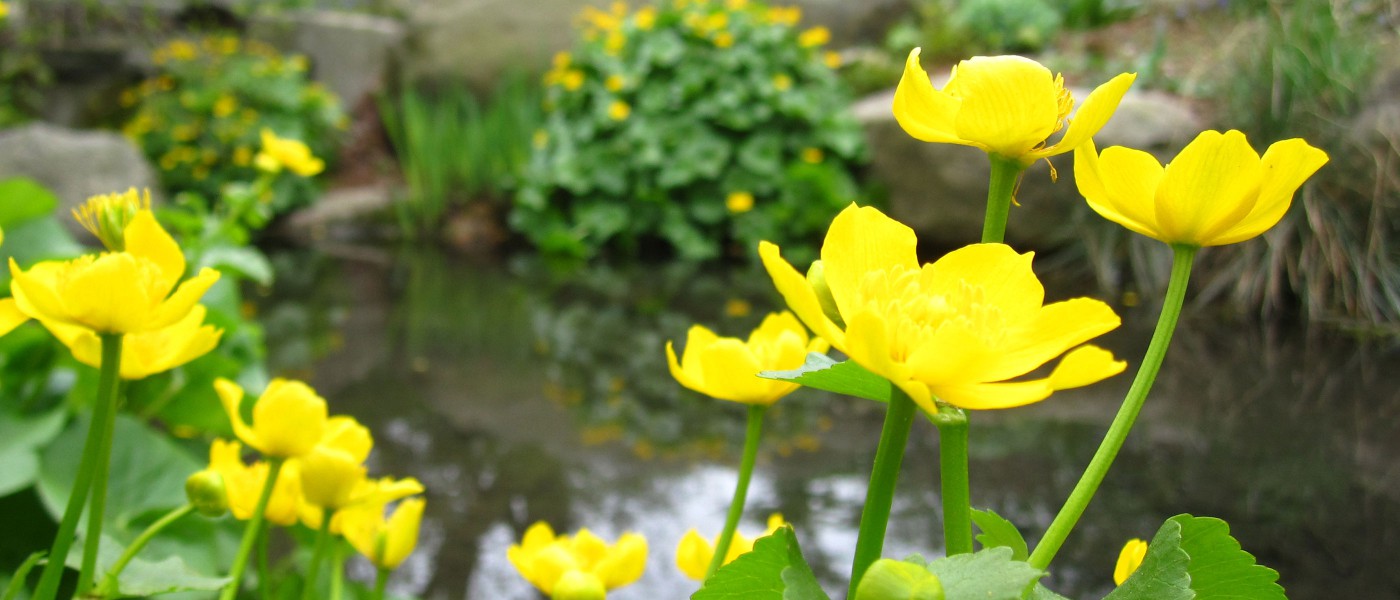Native Plants for New York City Rain Gardens
Rain gardens are shallow depressions designed to soak up water and support trees, shrubs, and flowers that tolerate both wet and dry conditions. Native plants are highly recommended for rain gardens because they are more pest resistant than nonnatives, require no fertilizer, and provide habitat for birds, butterflies, and other pollinators. Once established, the deep roots of native plants increase the water-holding capacity of the soil, hold it together, and prevent erosion.
Rain gardens usually have two to three moisture zones, ranging from wet (lower areas with periodically saturated soils and short periods of standing water) to upland (sloping edges with fast-draining or dry soils). Here are some North American native plants listed according to the conditions in a rain garden in which they thrive: wet, upland, sunny, or shady.
Herbaceous Plants for Sunny Wet Zone Sites
These choices are best beneath newly planted trees.
Flowers
Canada anemone (Anemone canadensis)
Swamp milkweed (Asclepias incarnata)
Marsh marigold (Caltha palustris)
Turtlehead (Chelone glabra)
Boneset (Eupatorium perfoliatum)
Joe-pye weed (Eupatorium maculatum)
Bedstraw (Galium boreale)
Bottle gentian (Gentiana andrewsii)
Sneezeweed (Helenium autumnale)
Giant sunflower (Helianthus giganteus)
Oxeye sunflower (Heliopsis helianthoides)
Blue flag (Iris versicolor)
Spike gayfeather (Liatris spicata)
Great blue lobelia (Lobelia siphilitica)
Prairie phlox (Phlox pilosa)
Virginia mountain mint (Pycnanthemum virginiana)
Meadowsweet (Spiraea alba)
New England aster (Symphyotrichum novae-angliae)
Tall meadow rue (Thalictrum dasycarpum)
Blue vervain (Verbena hastata)
Culver’s root (Veronicastrum virginicum)
Golden Alexander (Zizia aurea)
Grasses and Sedges
Blue joint grass (Calamagrostis canadensis)
Sedges (Carex, Scirpus, and other species )
Canada wild-rye (Elymus canadensis)
Rushes (Juncus species and others)
Rice cutgrass (Leersia oryzoides)
Indian grass (Sorghastrum nutans)
Cordgrass (Spartina pectinata)
Herbaceous Plants for Shady Wet Zone Sites
Flowers
Marsh marigold (Caltha palustris)
Turtlehead (Chelone glabra)
Joe-pye weed (Eupatorium purpureum)
Virginia waterleaf (Hydrophyllum virginianum)
Spotted touch-me-not (Impatiens capensis)
Cardinal flower (Lobelia cardinalis)
Canada mayflower (Maianthemum canadense)
Virginia bluebells (Mertensia virginica)
Woodland phlox (Phlox divaricata)
False dragonhead (Physostegia virginiana)
Tall meadow rue (Thalictrum dasycarpum)
Foamflower (Tiarella cordifolia)
Ferns
Sensitive fern (Onoclea sensibilis)
Cinnamon fern (Osmunda cinnamomea)
Interrupted fern (Osmunda claytoniana)
Royal fern (Osmunda regalis)
Marsh fern (Thelypteris palustris)
Herbaceous Plants for Sunny Upland Zone Sites
Flowers
Wild columbine (Aquilegia canadensis)
Butterfly weed (Asclepias tuberosa)
Tickseed ‘Moonbeam’ (Coreopsis verticillata ‘Moonbeam’)
Purple coneflower (Echinacea purpurea)
Oxeye sunflower (Heliopsis helianthoides)
Blazing star ‘Kobold’ (Liatris spicata ‘Kobold’)
Beebalm (Monarda didyma)
Black-eyed Susan (Rudbeckia hirta)
New England aster (Symphyotrichum novae-angliae)
Showy goldenrod (Solidago speciosa)
Grasses
Little bluestem (Schizachyrium scoparium)
Shrubs for Wet Zone Sites
Most of these species do well in sun or shade.
Buttonbush (Cephalanthus occidentalis)
Silky dogwood (Cornus amomum)
Gray dogwood (Cornus racemosa)
Red-osier dogwood (Cornus sericea)
Red-osier dogwood ‘Isanti’ (Cornus sericea ‘Isanti’)
Hazelnut (Corylus americana)
Dwarf bush honeysuckle (Diervilla lonicera)
Winterberry (Ilex verticillata)
Fragrant sumac (Rhus aromatica)
Meadowsweet (Spirea alba) (needs sun)
Snowberry (Symphorocarpos alba)
New York aster (Symphyotrichum novi-belgii)
Nannyberry (Viburnum lentago)
American cranberry (Viburnum trilobum)
American cranberry ‘Compacta’(Viburnum trilobum ‘Compacta’)
Herbaceous Plants for Shady Upland Zone Sites
Green-and-gold (Chrysogonum virginianum)
Wild geranium (Geranium maculatum)
Coral bells (Heuchera americana)
Virginia bluebells (Mertensia virginica)
Virginia creeper (Parthenocissus quinquefolia)
Partridgeberry (Mitchella repens)
Blue wood aster (Symphyotrichum cordifolium)
Shrubs for Shady Upland Zone Sites
Serviceberry (Amelanchier canadensis)
Ferns
Christmas fern (christmasfern)
Native Plant Sources
Never dig up plants that you find in undeveloped areas or on public land. To do so would benefit your garden at nature’s expense—and it is often illegal. Nurseries are beginning to sell more native plants as the demand for them increases, so ask your local nursery to stock them. Here are a few local nurseries that offer natives. Native plants are also widely available via mail order and online. Visit BBG’s Gardener’s Resource Center or bbg.org for more information.
Gowanus Nursery
9 Carroll Street, Brooklyn | 718-852-3116
Fort Pond Native Plants
Montauk, NY | 631-668-6452
HR Talmage
Riverhead, NY | 631-727-3100
Green Belt Native Propagation Center
Staten Island, NY | 718-370-9044
Toad Shade Wildflower Farm
Frenchtown, NJ | 908-996-7500
Bill Kolvek Perennials
Woodcliff, NJ | 845-735-2904



